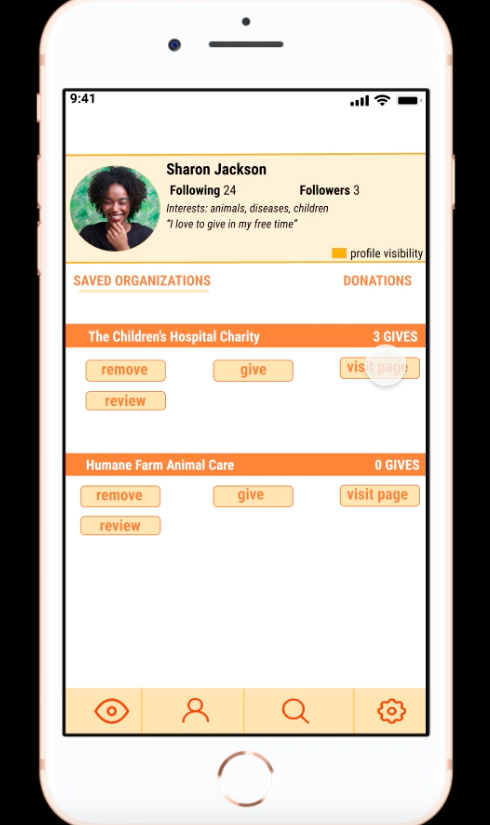


My semester long group project in my User Experience Design class was about gathering user research data, learning how to extract design requirements, and develop prototypes. Our team chose to improve upon the donation process by keeping individuals informed, aware, and in control of their donation. This project was completed in December 2019.
Mission Statement:
Our mission is to enhance the donation process through visual design and by providing feedback to customers about the use and impact made through the contribution.
Contextual Inquiries:
Subject A Interview Questions:
1) Can you recall a donation experience?
I frequently donate to different charities that are discussed at my church.
2) Can you walk me through the process that you go through when you contribute?
There is someone in the organization that talks about the charity during the service. While they are speaking about it, a donation basket is passed around and anyone who is interested can put money in. If they don’t have cash there is usually a link or someone you can Venmo that will make sure the money gets to the right place.
3) Does the organization keep you up to date on the difference your contribution made?
Yes. About two weeks after the donations are taken the organization comes back with some type of video or message that shows how the contributions were used and how it helped make a difference in people’s lives.
4) How do you find out if an organization is legitimate or not?
Frequently the organization provides a website that you can use to get a feel for their legitimacy. Also, since these organizations are promoted through church I usually am more willing to trust that they are reputable institutions.
5) How does donating make you feel, and why do you donate?
I donate to people because I feel like I have a small part in contributing good into the world. I do it because I believe we should help others who are struggling. One day, I might be the one in need of help, and I would hope others would do the same for me.
6) Do you believe your donation helps in the grand scheme of things?
Yes. I think all acts of good no matter how small make a difference, and if everyone does small acts they will add up to a lot of kindness around the world.
Subject B Interview Questions:
1) Can you recall a donation experience?
I often donate to fundraisers that are done through restaurant organizations such as Panda Express or Hibachi San.
2) Can you walk me through the process that you go through when you contribute?
I purchase my food and the cashier will ask all people during check out if they are interested in contributing to a charity. It is usually only a few dollars, so I usually try to say yes.
3) Does the organization keep you up to date on the difference your contribution made?
No. I never hear anything about the charity or where the money is used. I would actually really like an email or something that details how much money has been raised, if they have been able to buy new things for the charity, and how the money has been used to help others.
4) How do you find out if an organization is legitimate or not?
I usually try to think about if I have ever heard about that charity before and if it sounds reputable by the name. I don’t frequently go research them before or after; instead I trust in humanity and hope that the restaurants are trying to do good in the world.
5) How does donating make you feel, and why do you donate?
I feel like I am making a difference when I donate. I want to help people that are less fortunate because something that is fairly small and meaningless to you like $5 could be really beneficial to someone else.
6) Do you believe your donation helps in the grand scheme of things?
Yes, a little bit. I think the fact that many other people also donate means that all the small pieces add up to make a large difference overall.



Conclusion:
My group spent the semester designing a better process for donating money to charities. Through research and contextual inquiries we found that many college students are worried that the money they donate is not adequately used. We wanted to understand how students vetted the charities they donated to, and if they feel as though they are making a difference to those charities. From these interviews we listed the most important findings on Post-It notes and then created a digital affinity diagram. We condensed those findings into characteristics that we then split into two personas with associated motivations, fears, and goals. Keeping those characteristics in mind, we each sketched an individual design for an app that would meet the needs of our users. Finally, we worked together to combine the best parts of our individual designs to create the prototype below.
Our group received a great deal of positive feedback from our peers as well as from the professor. If we had more time, we would have done a second iteration of the app with a higher contrast color scheme, because some of our users said the white and orange could be difficult to read. Overall, I learned a lot about the process of user experience design. I loved finding the problems and identifying ways to make the experience better for people. This was easily my favorite project I have done in school, and I hope to further explore UX research in my last year of college.






